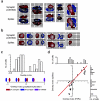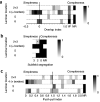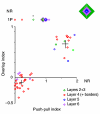Receptive field structure varies with layer in the primary visual cortex
- PMID: 15711543
- PMCID: PMC1987328
- DOI: 10.1038/nn1404
Receptive field structure varies with layer in the primary visual cortex
Abstract
Here we ask whether visual response pattern varies with position in the cortical microcircuit by comparing the structure of receptive fields recorded from the different layers of the cat's primary visual cortex. We used whole-cell recording in vivo to show the spatial distribution of visually evoked excitatory and inhibitory inputs and to stain individual neurons. We quantified the distribution of 'On' and 'Off' responses and the presence of spatially opponent excitation and inhibition within the receptive field. The thalamorecipient layers (4 and upper 6) were dominated by simple cells, as defined by two criteria: they had separated On and Off subregions, and they had push-pull responses (in a given subregion, stimuli of the opposite contrast evoked responses of the opposite sign). Other types of response profile correlated with laminar location as well. Thus, connections unique to each visual cortical layer are likely to serve distinct functions.
Figures








Comment in
-
Disentangling simple from complex cells.Nat Neurosci. 2005 Mar;8(3):266. doi: 10.1038/nn0305-266. Nat Neurosci. 2005. PMID: 15746912 No abstract available.
References
-
- Callaway EM. Local circuits in primary visual cortex of the macaque monkey. Annu. Rev. Neurosci. 1998;21:47–74. - PubMed
-
- Fitzpatrick D. The functional organization of local circuits in visual cortex: insights from the study of tree shrew striate cortex. Cereb. Cortex. 1996;6:329–341. - PubMed
-
- Lund JS, Henry GH, MacQueen CL, Harvey AR. Anatomical organization of the primary visual cortex (area 17) of the cat. A comparison with area 17 of the macaque monkey. J. Comp. Neurol. 1979;184:599–618. - PubMed
Publication types
MeSH terms
Grants and funding
LinkOut - more resources
Full Text Sources
Other Literature Sources
Miscellaneous

